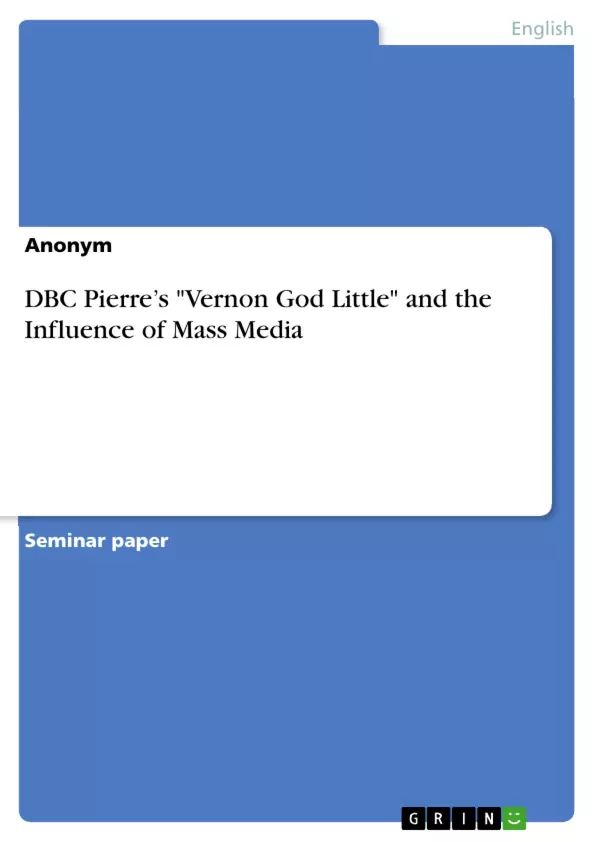This term paper deals with the topic of mass media in the novel "Vernon God Little" by DBC Pierre. It is particularly concerned with the question of through which techniques and in which ways the inhabitants of Martirio (the hometown of the protagonist Vernon) are influenced by mass media and news reports. It provides a topic analysis, which is divided into three sections:
Firstly, the overall importance of media (especially TV) in modern societies is discussed, including how it influences people’s attitudes, values etc. Secondly, it depicts different problems in journalism and how exaggeration and lies potentially influence someone’s opinion and even the judicial system. Thirdly, the novel serves as one example of how true crime and the reporting of it is part of the public ‘entertainment’ and how people make use of someone else’s tragedy.
The second part of this term paper consists of a didactic analysis of a lesson at a school or university. The aim of the lesson is to make the students aware of the importance and core issues of media literacy.
Table of Contents
- Introduction
- Topic Analysis
- The influence of mass media on the protagonist Vernon.
- Strategies and techniques of mass media to manipulate the public opinion
- Sensationalism in Vernon God Little
- Didactic Analysis
- Conclusion
- Works cited
- Appendix
- Lesson plan
- Worksheet A
- Worksheet B
- Possible ideas and suggestions of the students
Objectives and Key Themes
This term paper examines the role of mass media in DBC Pierre's novel "Vernon God Little," exploring its impact on individuals and society. The paper aims to analyze the influence of media on the protagonist, Vernon, and the manipulation of public opinion through various strategies and techniques. It further delves into the concept of sensationalism and its role in shaping public perception of tragedies.
- The influence of mass media on individuals, particularly Vernon's worldview and actions.
- The strategies and techniques employed by mass media to manipulate public opinion.
- The role of sensationalism in shaping public perception of tragedies.
- The impact of mass media on the judicial system and its potential to influence public opinion.
- The importance of media literacy in understanding and critically evaluating media messages.
Chapter Summaries
The introduction delves into the significance of mass media in modern society and the increasing critique surrounding its focus on commercialism over quality. It then introduces the novel "Vernon God Little" by DBC Pierre, highlighting the novel's themes of media influence on individuals and society, journalistic problems, and the exploitation of tragedies for public entertainment. The introduction further links the novel to the Columbine High School massacre and its aftermath, noting the subsequent focus on media criticism.
The second chapter, "Topic Analysis," is divided into three sections. The first section examines the influence of mass media on Vernon's worldview, showcasing how he constantly compares real-world events to television shows and movies. This section further emphasizes Vernon's difficulty in distinguishing between reality and fictional narratives.
The second section of the "Topic Analysis" chapter explores mass media techniques used to manipulate public opinion. It uses text passages to illustrate how these techniques subtly influence individuals' perspectives and actions. This section delves into the concept of "tragedy as entertainment" and its role in shaping public perception of tragedies.
Keywords
The key themes and concepts explored in this paper include mass media influence, media literacy, sensationalism, manipulation of public opinion, journalism ethics, and the impact of media on individuals and society. The paper further explores the relationship between tragedy and entertainment, and the influence of media narratives on public perception and the judicial system.
- Quote paper
- Anonym (Author), 2020, DBC Pierre’s "Vernon God Little" and the Influence of Mass Media, Munich, GRIN Verlag, https://www.grin.com/document/1025676



